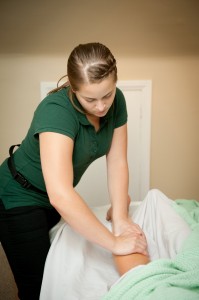 Restless Leg Syndrome (RLS) is a type of sleep disorder where a person feels a crawling, tingling sensation usually in their extremities (usually the lower leg) and they feel the need to move or massage their limb for relief. This disorder does not have a specific means to diagnosis; however, it usually is hereditary or can occur with other conditions such as pregnancy, diabetes, or fibromyalgia. The symptoms of RLS may occur at anytime, but usually present themselves at night when a person is the most still and is trying to sleep.
Restless Leg Syndrome (RLS) is a type of sleep disorder where a person feels a crawling, tingling sensation usually in their extremities (usually the lower leg) and they feel the need to move or massage their limb for relief. This disorder does not have a specific means to diagnosis; however, it usually is hereditary or can occur with other conditions such as pregnancy, diabetes, or fibromyalgia. The symptoms of RLS may occur at anytime, but usually present themselves at night when a person is the most still and is trying to sleep.
Although it is not known what causes RLS, research has made a connection between a lack of the hormone dopamine and the condition. Dopamine is a “feel good” hormone that is released from the brain to help relax you. If this hormone is low, a person may find it difficult to relax, sleep, or the person may start feeling more sensitive and twitchy.
If you suffer from RLS keep in mind a couple of lifestyle changes you could make to decrease your symptoms. Nutrition has been found to play a huge part in RLS symptoms. By decreasing your intake of coffee, sugars, alcohol and foods that contain white flour you could find a huge difference. Taking a vitamin supplement of magnesium and calcium will also help calm the symptoms that are making it impossible to get a decent nights rest.
Massage and hydrotherapy can also play an important role in reducing RLS symptoms. Massage helps reduce stress, takes knots out of muscles that could cause twitches or spasms, and helps balance hormones which include dopamine. Massage also helps increase your sleep and relaxation. Warm baths are also recommended for RLS clients before going to sleep. Warm water will help penetrate deep into the muscles to completely relax them.
If you are a sufferer of Restless Leg Syndrome, book a massage today to help decrease your symptoms and get you the rest that you need!

 When a child is young and has a tummy ache the mother will rub the child’s belly to try to make it feel better. This, in a sense, is a type of very basic massage for the stomach. Most people wouldn’t think of going to see a massage therapist to help with conditions regarding gastrointestinal concerns, but massage therapy can actually help and it works very similar to the child with a tummy ache.
When a child is young and has a tummy ache the mother will rub the child’s belly to try to make it feel better. This, in a sense, is a type of very basic massage for the stomach. Most people wouldn’t think of going to see a massage therapist to help with conditions regarding gastrointestinal concerns, but massage therapy can actually help and it works very similar to the child with a tummy ache.